As temperatures start to cool off, you may find yourself looking for new, warmer clothing. What you’ll find in stores is plenty of clothing, jackets, and coats made from polyester and wool. But when searching for that perfect new coat, how do you know which of these materials to choose? Which one is better?
The main difference between polyester and wool is that polyester is a synthetic fabric while wool is a natural fabric. Since polyester is synthetic, it is more durable and easy to care for, but it isn’t as warm and breathable. Wool is a natural fabric, so it is more expensive and requires more care. However, it is more breathable, warmer, and more water-resistant, so it is better to wear in the cold and snow.
But which is better: polyester or wool? That’s why I’ve written this guide to polyester and wool fabrics. We will use this guide to compare polyester vs wool. Hopefully, it will help make your decision easier. Continue reading to learn more.

Polyester vs. Wool: Key Points
| Polyester | Wool | |
|---|---|---|
| Breathability | Breathable | More breathable than polyester |
| Durability | Very durable, shrink and wrinkle resistant | Very durable as long as it is taken care of |
| Softness | Some versions are softer than others | Soft but can feel scratchy to some people |
| Warmth | Warm | Warmer than polyester |
| Moisture Wicking | Water-resistant, dries quickly | Very water-resistant, naturally repels water but will take longer to dry |
| Ease of Care | Very easy, just avoid high temperatures | Requires more care, dry cleaning is preferred but can be hand-washed |
| Cost | Inexpensive | More expensive |
| Uses | Clothing, coats, athletic wear, lining for jackets | Winter clothing, coats, blankets, socks, scarves |
What is Polyester Fabric?
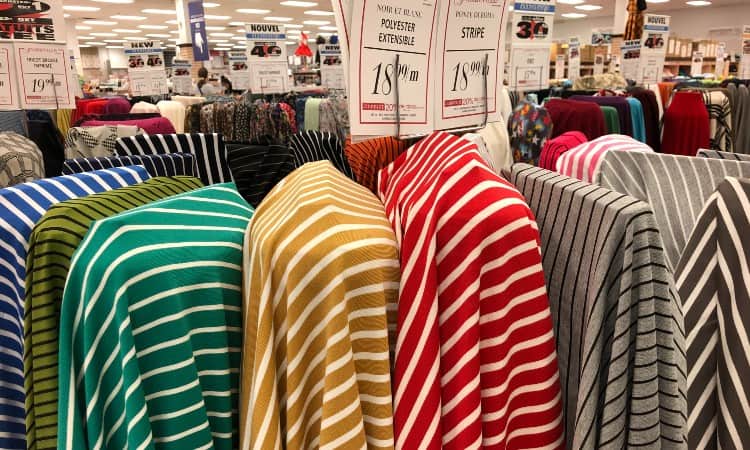
Polyester is a synthetic fabric, which means that it was invented instead of being found in nature. Although it was created in the 1940s, it is still a newer type of fabric compared to natural fabrics like cotton, silk, and wool that have been around since ancient times. Although it was created in the 1940s, it didn’t take off until about 30 years later, when it was hailed as a “miracle fabric.”
It was called a miracle fabric because of its versatility and ability to resist staining and wrinkles. It was very easy to take care of compared to other fabrics that had been on the market up until that point. But polyester is so versatile and has the qualities that it does because it is made from plastic.
When you think of plastic, you don’t tend to think of fabric. But it’s not so much the texture that makes it plastic; it’s what it’s made of. Polyester is made from petroleum that comes from crude oil. Petroleum is used to create different polymers, which is what makes up plastic.
But there isn’t just one type of polymer. The polymers can be modified to have different characteristics. That’s why polyester looks different than the things you commonly know as plastic. Since plastic can be modified, that means that there are different types of polyester fibers with different textures as well.
The basic process for making polyester fibers is this. First, the fibers have to be created out of petroleum and other chemicals to give them certain characteristics. Then, the fibers are spun together to create yarn. The yarns are woven together to create fabric. But they can be woven in different ways to create certain fabric appearances. That’s why two clothing items made out of polyester may look and feel different.
What is Wool Fabric?
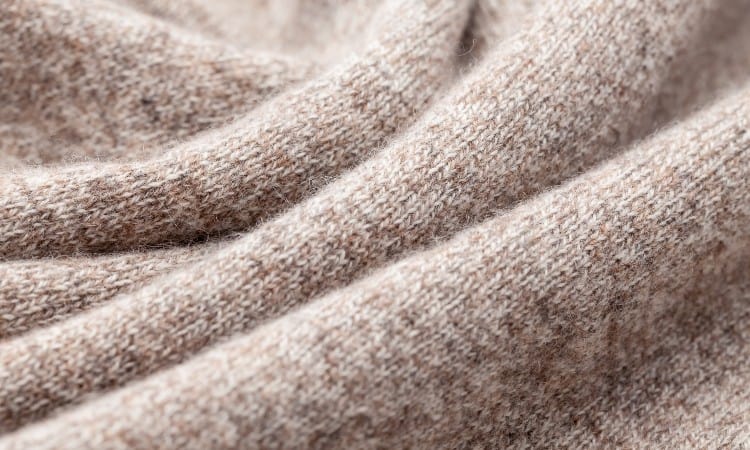
Wool is one of the oldest natural fabrics, having been used to make clothing and other textiles for centuries. When we think of wool, usually sheep is what comes to mind. Although a majority of wool does come from sheep, there are different types of sheep’s wool. There are also other animals that produce wool besides sheep, including alpacas, llamas, and goats.
Since there is an abundance of sheep in many countries around the world, sheep’s wool is the most commonly used for textiles. Because of this, it is also the least expensive wool. However, wool from certain breeds of sheep, such as Merino, does tend to be more expensive.
Wool from less common animals, like alpacas, can be really expensive. This is due to the animals being found only in certain countries and shorn once a year. Types of wool such as alpaca aren’t as abundant, which means that it will cost more money to get fabric or clothing made from that type of wool.
The thing about wool fabric is that the animals that produce wool aren’t being shorn just to make the fabric. Shearing wool-bearing animals is good for their health. Otherwise, the wool could get tangled and dirty, making it a breeding ground for bacteria. This could make the animal sick.
But once the wool was shorn, it was just sitting there, so people found a way to make it useful. That’s how wool fabric came about. To make the fabric, the wool has to first be sorted and cleaned. Then, several fibers are spun together to create wool yarn. Lastly, several yarns are woven together on looms to make wool fabric.
What’s the Difference Between Polyester and Wool?
Although these fabrics are used for similar products, they each have some unique characteristics. So now that you have a little bit of background information about how these two fabrics came about, it’s time to discuss the more specific differences between them. Remember that it all boils down to one thing: one is a synthetic fabric and the other is a natural fabric.
Breathability
 With fabrics that you wear to keep you warm, you don’t want them to feel stuffy as a result. That’s why breathability is an important factor to look at when describing factors. The great thing about polyester and wool is that they are both breathable.
With fabrics that you wear to keep you warm, you don’t want them to feel stuffy as a result. That’s why breathability is an important factor to look at when describing factors. The great thing about polyester and wool is that they are both breathable.
Since polyester is man-made, it can be made to be more breathable than other fabrics. Some versions of polyester may also be more breathable than others, depending on how they are woven. However, sometimes polyester can have a flame-retardant or waterproof coating on it. Any type of coating can lower breathability.
Since wool is a natural fiber, it is more breathable than polyester. Since wool is a coat for animals, it has to be naturally breathable to keep the animals cool. Air can also circulate through wool better. So in terms of breathability, wool is the better choice.
Durability
Since polyester is synthetic, it can be made to be more durable than other fabrics. Polyester is one of the most durable fabrics there is. It is very resistant to wrinkles and shrinking and it requires very little special care. The only thing that can damage polyester is high levels of heat. There’s a reason why your polyester clothing lasts for such a long time.
Wool is also a very durable fabric. It is a heavy and thick fabric that can last for many years. It isn’t wrinkle- and shrink-resistant, but it does resist wrinkles and shrinking better than other natural fabrics like cotton and linen. Wool does require special care, though, to keep it in good shape. So overall, the durability advantage goes to polyester.
Softness
Polyester can be made to have different textures depending on the type of clothing it will be used for. Some polyester may feel harder and stiffer, while others can feel just as soft as wool or softer. One example is a fleece. Fleece is made from polyester, but it is meant to serve as a cheaper version of wool fabric. There are also different types of polyester fleece and some are softer than others.
Wool is a naturally soft fabric. But since there are different types of wool from different animals, some may feel softer than others. For example, alpaca wool is one of the softest there is. Cashmere is another type of wool that is very soft. However, some people can be allergic to wool and they may or may not know it. Allergies or sensitive skin may cause wool to feel scratchy to those people.
Warmth
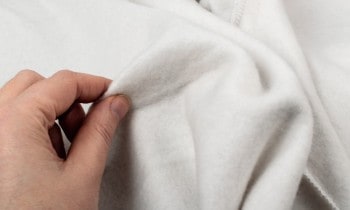 Polyester can be a warming or cooling fabric, depending on how it is made. With that being said, there are many jackets and other types of winter clothing made from polyester. Sometimes polyester can be stiffer and used as protection from wind which can keep you warm. In other instances, polyester fleece is more insulating and can keep you warm that way.
Polyester can be a warming or cooling fabric, depending on how it is made. With that being said, there are many jackets and other types of winter clothing made from polyester. Sometimes polyester can be stiffer and used as protection from wind which can keep you warm. In other instances, polyester fleece is more insulating and can keep you warm that way.
Wool is even warmer than polyester and is one of the warmest fabrics there is. Since most of the animals that produce wool live in regions where it can get really cold in the winter, wool will keep those animals warm. It works the same way for people who wear wool fabrics. So especially if you live somewhere with really cold winters, wool is the better choice for warmth.
Moisture Wicking
Polyester is one fabric that is commonly used for athletic wear. It is moisture-wicking, so it will keep you dry while you sweat. Polyester is also used for rain jackets and swimwear because of its ability to keep you dry. However, you should note that polyester is only water-resistant to a certain extent. It is not waterproof. But even if it does get wet, it will dry fairly quickly.
Wool is naturally moisture-wicking and water-resistant. This is to help keep animals dry, especially in really cold and snowy conditions. Wool can also absorb around 30% of its weight in water before it starts to become saturated. If that happens, it will take a little longer to dry than polyester. But overall, wool is a popular fabric choice for winter adventuring.
Ease of Care
If you want a incredibly easy fabric to care for, then polyester is the way to go. It is machine-washable and can be dried in the dryer since you don’t have to worry about it shrinking. And since it is pretty resistant to stains, you also don’t have to do a lot of pre-treatment before washing it. The only thing to look out for is that polyester fibers can melt. Just don’t use hot water or high heat when washing and drying, and you should be fine.
Wool, on the other hand, requires more care. Natural fibers are more susceptible to damage and shrinking when washed and dried, and wool is no exception. The recommended way to clean wool is to have it dry-cleaned.
But if that isn’t an option, you can always wash it by hand. If you do this, use cool water and a detergent designed for wool. You should also avoid putting wool in the dryer- letting it air-dry is best. Some types of wool can be washed in the washing machine if it is blended with other fibers. But you should always check the care tag to see if it is machine washable before doing so.
Cost
Between these two fabrics, polyester is the cheaper one. This is because of what it’s made of and how it is made. It is quicker and easier to produce polyester fabric than wool. That’s why polyester fabric is so readily available and widely used.
Wool is an expensive fabric because it can’t be produced as easily as polyester. Some types of wool are more expensive than others due to being rarer. For example, vicuna wool is one of the rarest and most expensive types of wool. It is even considered to be a luxury fabric. The bottom line is that you can expect to pay more for wool clothing versus polyester.
Uses
Polyester has all kinds of uses. It can be used as a lining or it can be the primary material that clothing is made. You can find polyester in anything from swimwear to athletic wear to coats to household fabrics like curtains and sheets. It is also common to find polyester blended with cotton or spandex for an even wider range of uses.
Wool is mainly used for clothing that is designed to keep you warm. A lot of clothing made from wool can be found when stores start putting their winter merchandise out. Wool is used for sweaters, socks, scarves, and even blankets. Most peacoats that you find for sale in winter are also made from wool.
Pros and Cons of Polyester
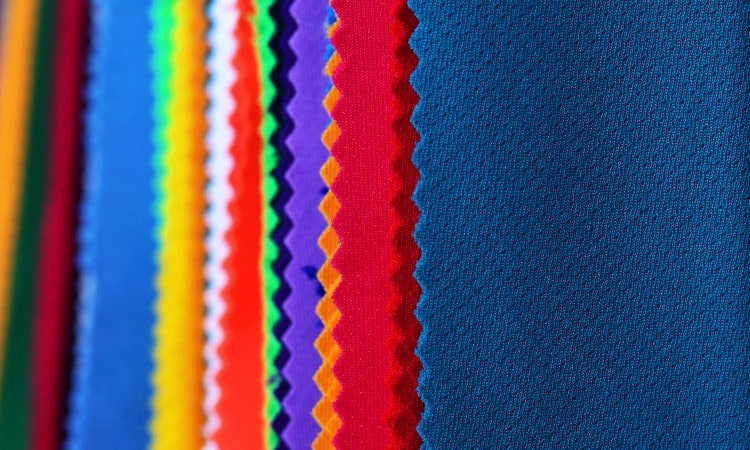
Now that you know the characteristics of polyester in more detail let’s look at the pros and cons. Polyester is one of the most versatile fabrics there is. It has a wide range of uses and is incredibly durable. Since it is widely available, it is also one of the cheapest fabrics.
However, it does have its downsides. One of them is that winter clothing made from polyester isn’t the warmest or most breathable option. And polyester is synthetic, which means it isn’t the most sustainable option. However, you can feel better about wearing it since it usually lasts a very long time. Lastly, polyester can get damaged if you accidentally wash or dry it using high temperatures.
Pros and Cons of Wool
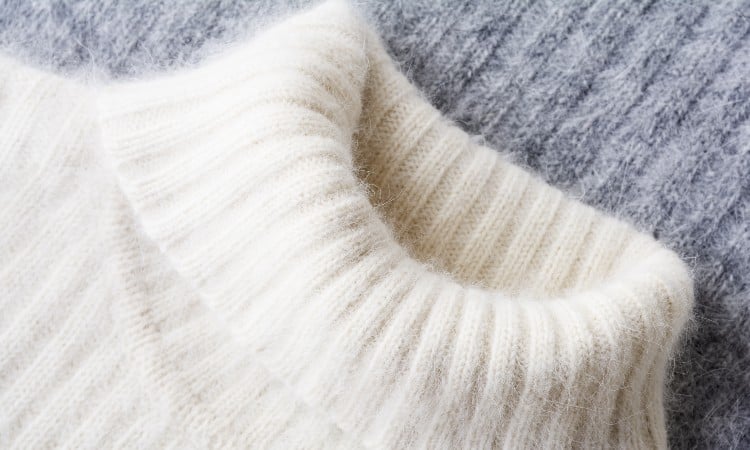
Wool also has its pros and cons. As far as fabrics go, it is one of the warmest you can buy. It is also naturally breathable, moisture-wicking, and odor resistant. And by choosing wool, you can feel good about wearing sustainable fabric since it is a natural fiber.
There are downsides to wool that may steer people away from it. One of these is that wool requires special care. You can’t just throw it in the washing machine and be done with it. Another downside is that not everyone can wear wool due to allergies or sensitive skin. And lastly, wool can be really expensive depending on the type that you buy.
Should You Buy Polyester or Wool?
Okay, we’ve examined the characteristics of these fabrics and looked at the pros and cons. So how do you know which one to buy? Well, in terms of the most favorable characteristics, wool is the all-around better choice. However, you should consider the pros and cons of each when you make your decision.
You should also keep in mind your budget. Wool is more expensive, so if you’re looking to save money, then polyester is still a good fabric choice. And even if you do shell out the big bucks for wool, you want to make sure you get your money’s worth. That means that if you live somewhere that stays pretty warm or mild, even in winter, you may not wear the wool fabric as much as polyester. It could be too warm.
Lastly, consider how much time you have to spend on doing laundry and caring for your clothing. Since wool requires more care, you may prefer polyester that you don’t have to spend as much time on. Even if you take the easier route and have wool dry-cleaned, that still requires money which could factor into your budget.
Popular Products Made of Polyester
Men’s Jacket
 Columbia Men's Softshell Jacket is made from 100% polyester fabric. It is perfect to wear while hiking or exploring the outdoors on a cool day. In the event of rain or wind, the material and high neck will keep you warm and protected from the elements.
Columbia Men's Softshell Jacket is made from 100% polyester fabric. It is perfect to wear while hiking or exploring the outdoors on a cool day. In the event of rain or wind, the material and high neck will keep you warm and protected from the elements.
There are 12 colors and 6 sizes that you can choose from. Three front pockets with zipper closures will keep your things secure, or you can just place your hands in to keep them warm. And another great quality is that this jacket is machine washable, so caring for it is easy.
Women’s Jacket
 Benton Springs Full Zip Fleece Jacket is made out of 100% polyester fleece, so it is just as soft as it is warm. It would be perfect to wear by itself on a mild winter day or as a base layer in the snow. If you’re going to be active outdoors, this might be the jacket for you.
Benton Springs Full Zip Fleece Jacket is made out of 100% polyester fleece, so it is just as soft as it is warm. It would be perfect to wear by itself on a mild winter day or as a base layer in the snow. If you’re going to be active outdoors, this might be the jacket for you.
The jacket is available in 34 colors, so you’re sure to find one that fits your style and personality. It comes in 6 sizes, as well as petite and plus sizes, so that you can get the perfect fit. Lastly, being machine washable is great if you prefer low-maintenance clothing.
Popular Products Made of Wool
Men’s Wool Sweater
 This men’s sweater is casual, cozy, and perfect for cold winter days.
This men’s sweater is casual, cozy, and perfect for cold winter days.
The fabric is made from 100% lambswool and is breathable while still keeping you warm. It even comes in 25 different colors and patterns, so you have a wide variety of options to choose from.
The sweater comes in sizes ranging from Small to 3X-Large. It even comes in tall sizes as well, so there is an option for every man. It is hand-wash or dry clean only, but the extra care is worth it for a sweater this comfy.
Women’s Wool Shirt
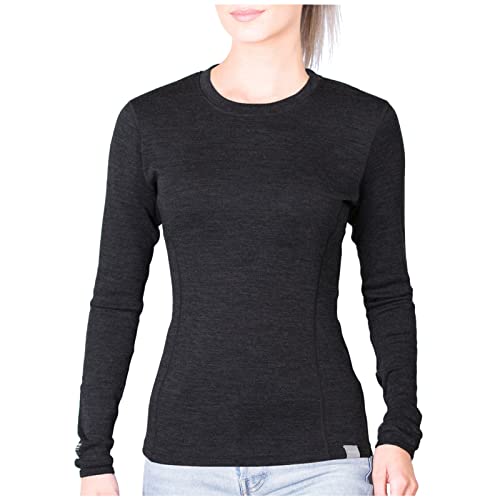 This women’s thermal shirt is long-sleeved, thermal, and made from 100% Merino wool. It is perfect to wear by itself or use as a base layer under any type of clothing. It comes in 9 different colors and 4 sizes.
This women’s thermal shirt is long-sleeved, thermal, and made from 100% Merino wool. It is perfect to wear by itself or use as a base layer under any type of clothing. It comes in 9 different colors and 4 sizes.
The athletic look and fit mean that you can exercise outdoors while still keeping warm. And due to wool’s natural water and odor-resistant properties, this shirt will keep you dry and feeling fresh while you’re active. What’s even better is that the shirt is machine washable as long as you use cold water.
Conclusion
I hope this guide was helpful for you to understand the differences between polyester and wool. Both of them have their pros and cons, but they are great fabrics in their own way. The best choice for you depends on where you live and what characteristics you look for in a fabric. If you enjoyed this article, share it with others and leave a comment. Thanks for reading!